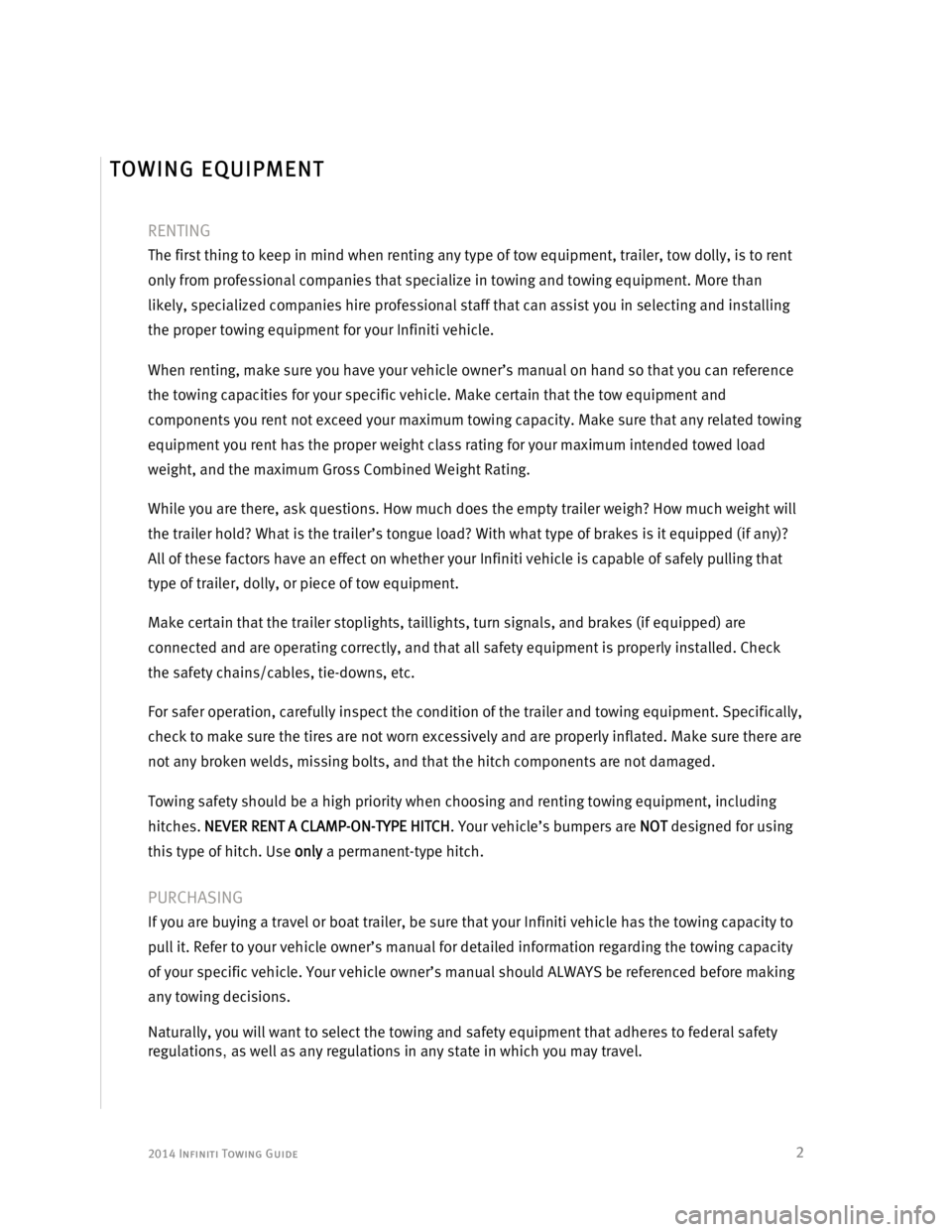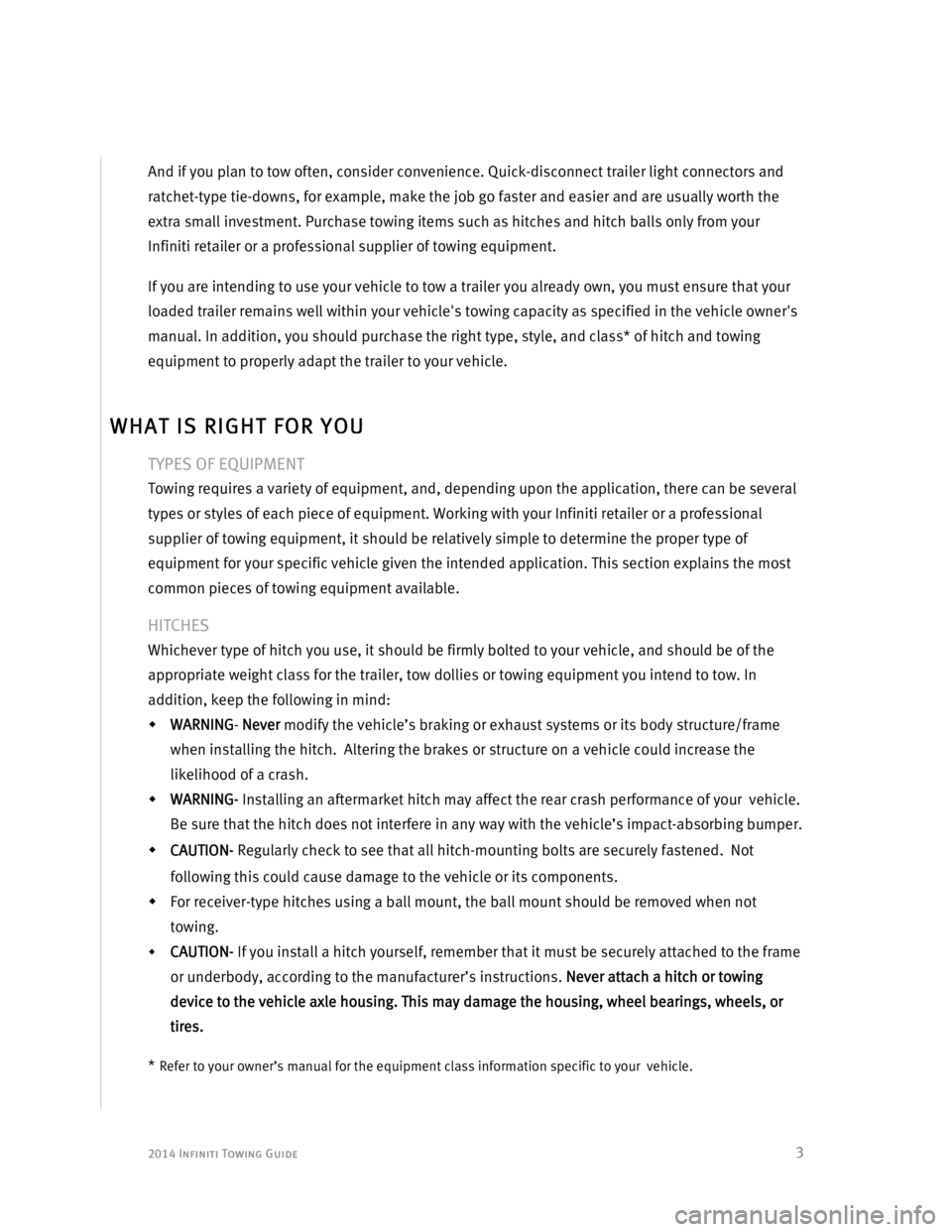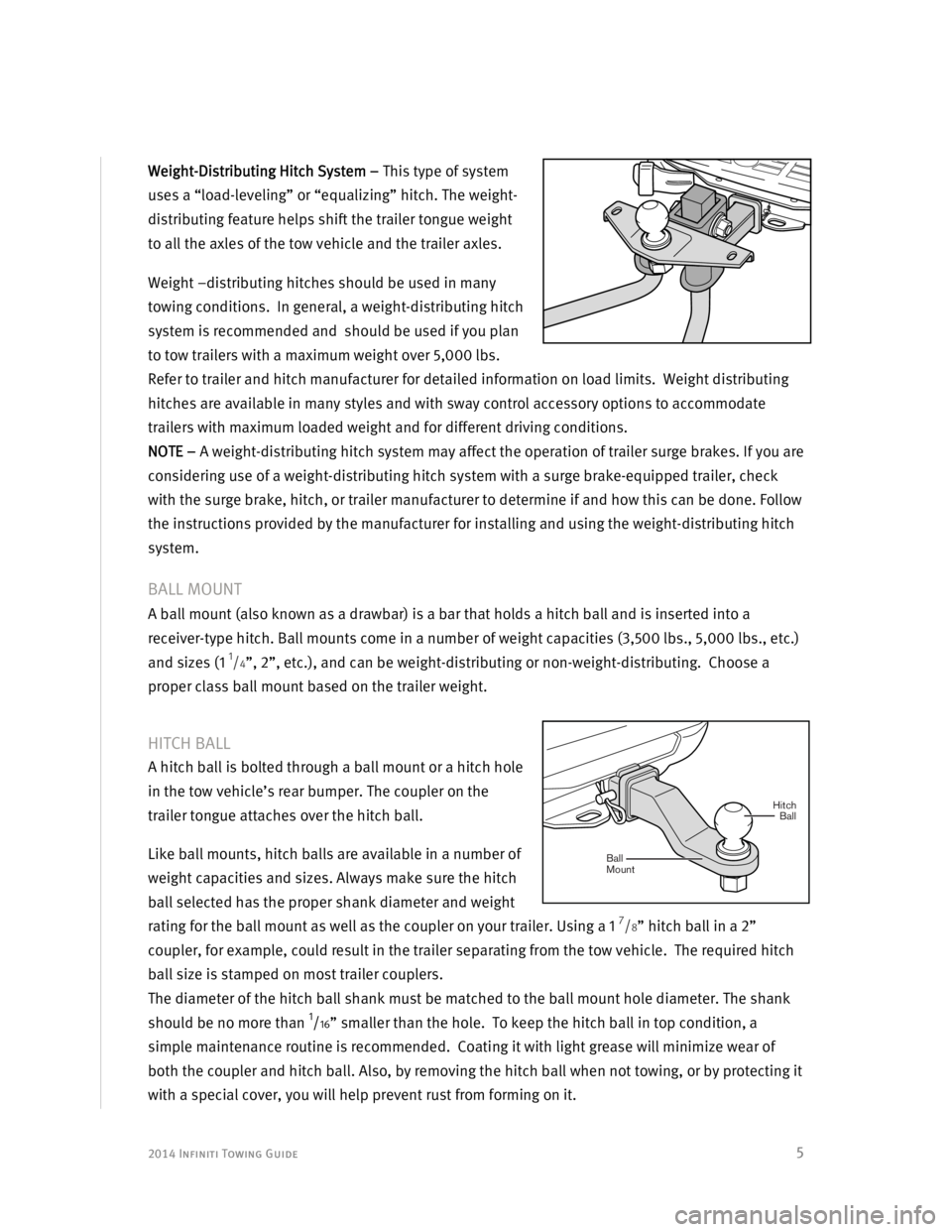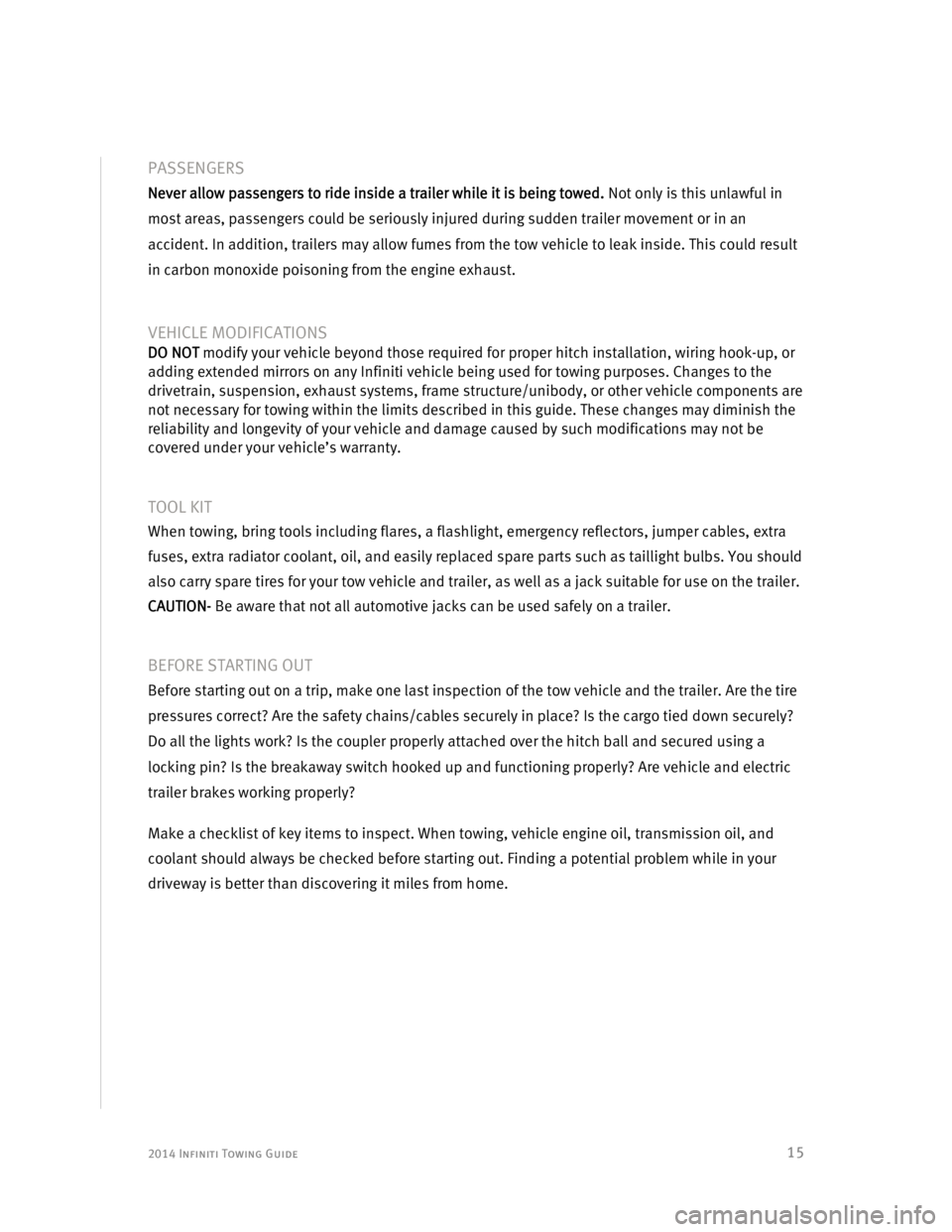brake light INFINITI QX60 2014 Towing Guide
[x] Cancel search | Manufacturer: INFINITI, Model Year: 2014, Model line: QX60, Model: INFINITI QX60 2014Pages: 25, PDF Size: 0.88 MB
Page 3 of 25

2014 Infiniti Towing Guide
2
RENTING
The first thing to keep in mind when renting any type of tow equipment, trailer, tow dolly, is to rent
only from professional companies that specialize in towing and towing equipment. More than
likely, specialized companies hire professional staff that can assist you in selecting and installing
the proper towing equipment for your Infiniti vehicle.
When renting, make sure you have your vehicle owner’s manual on hand so that you can reference
the towing capacities for your specific vehicle. Make certain that the tow equipment and
components you rent not exceed your maximum towing capacity. Make sure that any related towing
equipment you rent has the proper weight class rating for your maximum intended towed load
weight, and the maximum Gross Combined Weight Rating.
While you are there, ask questions. How much does the empty trailer weigh? How much weight will
the trailer hold? What is the trailer’s tongue load? With what type of brakes is it equipped (if any)?
All of these factors have an effect on whether your Infiniti vehicle is capable of safely pulling that
type of trailer, dolly, or piece of tow equipment.
Make certain that the trailer stoplights, taillights, turn signals, and brakes (if equipped) are
connected and are operating correctly, and that all safety equipment is properly installed. Check
the safety chains/cables, tie-downs, etc.
For safer operation, carefully inspect the condition of the trailer and towing equipment. Specifically,
check to make sure the tires are not worn excessively and are properly inflated. Make sure there are
not any broken welds, missing bolts, and that the hitch components are not damaged.
Towing safety should be a high priority when choosing and renting towing equipment, including
hitches. NEVER RENT A CLAMP-ON-TYPE HITCH. Your vehicle’s bumpers are NOT designed for using
this type of hitch. Use only a permanent-type hitch.
PURCHASING
If you are buying a travel or boat trailer, be sure that your Infiniti vehicle has the towing capacity to
pull it. Refer to your vehicle owner’s manual for detailed information regarding the towing capacity
of your specific vehicle. Your vehicle owner’s manual should ALWAYS be referenced before making
any towing decisions.
Naturally, you will want to select the towing and safety equipment that adheres to federal safety
regulations, as well as any regulations in any state in which you may travel.
TOWING EQUIPMENT
Page 4 of 25

2014 Infiniti Towing Guide
3
And if you plan to tow often, consider convenience. Quick-disconnect trailer light connectors and
ratchet-type tie-downs, for example, make the job go faster and easier and are usually worth the
extra small investment. Purchase towing items such as hitches and hitch balls only from your
Infiniti retailer or a professional supplier of towing equipment.
If you are intending to use your vehicle to tow a trailer you already own, you must ensure that your
loaded trailer remains well within your vehicle's towing capacity as specified in the vehicle owner's
manual. In addition, you should purchase the right type, style, and class* of hitch and towing
equipment to properly adapt the trailer to your vehicle.
TYPES OF EQUIPMENT
Towing requires a variety of equipment, and, depending upon the application, there can be several
types or styles of each piece of equipment. Working with your Infiniti retailer or a professional
supplier of towing equipment, it should be relatively simple to determine the proper type of
equipment for your specific vehicle given the intended application. This section explains the most
common pieces of towing equipment available.
HITCHES
Whichever type of hitch you use, it should be firmly bolted to your vehicle, and should be of the
appropriate weight class for the trailer, tow dollies or towing equipment you intend to tow. In
addition, keep the following in mind:
�Š WARNING- Never modify the vehicle’s braking or exhaust systems or its body structure/frame
when installing the hitch. Altering the brakes or structure on a vehicle could increase the
likelihood of a crash.
�Š WARNING- Installing an aftermarket hitch may affect the rear crash performance of your vehicle.
Be sure that the hitch does not interfere in any way with the vehicle’s impact-absorbing bumper.
�Š CAUTION- Regularly check to see that all hitch-mounting bolts are securely fastened. Not
following this could cause damage to the vehicle or its components.
�Š For receiver-type hitches using a ball mount, the ball mount should be removed when not
towing.
�Š CAUTION- If you install a hitch yourself, remember that it must be securely attached to the frame
or underbody, according to the manufacturer’s instructions. Never attach a hitch or towing
device to the vehicle axle housing. This may damage the housing, wheel bearings, wheels, or
tires.
*
Refer to your owner’s manual for the equipment class information specific to your vehicle.
WHAT IS RIGHT FOR YOU
Page 6 of 25

2014 Infiniti Towing Guide
5
Weight-Distributing Hitch System – This type of system
uses a “load-leveling” or “equalizing” hitch. The weight-
distributing feature helps shift the trailer tongue weight
to all the axles of the tow vehicle and the trailer axles.
Weight –distributing hitches should be used in many
towing conditions. In general, a weight-distributing hitch
system is recommended and should be used if you plan
to tow trailers with a maximum weight over 5,000 lbs.
Refer to trailer and hitch manufacturer for detailed information on load limits. Weight distributing
hitches are available in many styles and with sway control accessory options to accommodate
trailers with maximum loaded weight and for different driving conditions.
NOTE – A weight-distributing hitch system may affect the operation of trailer surge brakes. If you are
considering use of a weight-distributing hitch system with a surge brake-equipped trailer, check
with the surge brake, hitch, or trailer manufacturer to determine if and how this can be done. Follow
the instructions provided by the manufacturer for installing and using the weight-distributing hitch
system.
BALL MOUNT
A ball mount (also known as a drawbar) is a bar that holds a hitch ball and is inserted into a
receiver-type hitch. Ball mounts come in a number of weight capacities (3,500 lbs., 5,000 lbs., etc.)
and sizes (1
1/4”, 2”, etc.), and can be weight-distributing or non-weight-distributing. Choose a
proper class ball mount based on the trailer weight.
HITCH BALL
A hitch ball is bolted through a ball mount or a hitch hole
in the tow vehicle’s rear bumper. The coupler on the
trailer tongue attaches over the hitch ball.
Like ball mounts, hitch balls are available in a number of
weight capacities and sizes. Always make sure the hitch
ball selected has the proper shank diameter and weight
rating for the ball mount as well as the coupler on your trailer. Using a 1
7/8” hitch ball in a 2”
coupler, for example, could result in the trailer separating from the tow vehicle. The required hitch
ball size is stamped on most trailer couplers.
The diameter of the hitch ball shank must be matched to the ball mount hole diameter. The shank
should be no more than
1/16” smaller than the hole. To keep the hitch ball in top condition, a
simple maintenance routine is recommended. Coating it with light grease will minimize wear of
both the coupler and hitch ball. Also, by removing the hitch ball when not towing, or by protecting it
with a special cover, you will help prevent rust from forming on it.
Hitch
Mount BallBall
Page 8 of 25

2014 Infiniti Towing Guide
7
Telescoping Tow Mirrors are available as an accessory for certain Infiniti vehicles. Contact your
Infiniti retailer for details.
SWAY CONTROL DEVICE
Sudden maneuvers, wind gusts, and buffeting caused by other vehicles can affect trailer handling.
Sway control devices may help control the pivoting motion between tow vehicle and trailer and
make trailer towing easier on the driver. If you choose to use one, contact a reputable trailer hitch
supplier to make sure the sway control device will work with the vehicle, hitch, trailer and the
trailer’s brake system. A sway control device is recommended for all towing above 2,000 lb (907
kg). Too low a percentage of tongue weight can also cause sway. Follow the instructions provided
by the manufacturer for installing and using the sway control device.
BREAKAWAY SWITCH
On a trailer with electric brakes, a breakaway switch can automatically activate the trailer brake
system if the trailer becomes separated from the tow vehicle. Should the trailer become detached,
a breakaway switch may help prevent the trailer from wandering into another lane. A breakaway
switch relies on the power of a trailer battery, so make sure it is not discharged. Never use the
breakaway switch to “park” the trailer on a grade. The battery would eventually discharge and
release the brake, allowing the trailer to roll.
Be sure to leave enough slack in the tether on the breakaway switch to turn corners without
binding. If you do not, the electric trailer brakes will lock-up and not release. See your trailer
manufacturer for proper installation of a breakaway switch that is compatible with your trailer
braking system.
TRAILER LIGHTS
Trailer lights should comply with all applicable federal, state, and local regulations, and should be
in proper working order at all times. A trailer’s taillights, stoplights, and turn signal lights must be
wired into the towing vehicle’s electrical system.*
Most trailers operate on a four-wire system in which the stoplights and turn signal lights utilize the
same wire. Most all Infiniti vehicles have separate wires for the stoplights and turn signal lights,
therefore a device called a “converter” is needed.** Specifically, a “powered converter” must be
used, as a converter of this type creates only minimal additional electrical demand (draw) on the
vehicle lighting circuits, which helps to ensure protection for the vehicle’s sensitive electronics.
Always check for correct operation of the taillights, stoplights, and turn signal lights every time you
connect a trailer for towing. Never replace vehicle fuses with fuses of a higher amperage rating than
the original.
*Vehicles equipped with LED taillights require that wiring be connected at a specific location. For assistance in
hooking up trailer lights, contact your Infiniti retailer or a professional supplier of towing equipment.
**QX80 and QX60 vehicles are pre-wired for trailer lighting and do not require a converter.
Page 16 of 25

2014 Infiniti Towing Guide
15
PASSENGERS
Never allow passengers to ride inside a trailer while it is being towed. Not only is this unlawful in
most areas, passengers could be seriously injured during sudden trailer movement or in an
accident. In addition, trailers may allow fumes from the tow vehicle to leak inside. This could result
in carbon monoxide poisoning from the engine exhaust.
VEHICLE MODIFICATIONS
DO NOT modify your vehicle beyond those required for proper hitch installation, wiring hook-up, or
adding extended mirrors on any Infiniti vehicle being used for towing purposes. Changes to the
drivetrain, suspension, exhaust systems, frame structure/unibody, or other vehicle components are
not necessary for towing within the limits described in this guide. These changes may diminish the
reliability and longevity of your vehicle and damage caused by such modifications may not be
covered under your vehicle’s warranty.
TOOL KIT
When towing, bring tools including flares, a flashlight, emergency reflectors, jumper cables, extra
fuses, extra radiator coolant, oil, and easily replaced spare parts such as taillight bulbs. You should
also carry spare tires for your tow vehicle and trailer, as well as a jack suitable for use on the trailer.
CAUTION- Be aware that not all automotive jacks can be used safely on a trailer.
BEFORE STARTING OUT
Before starting out on a trip, make one last inspection of the tow vehicle and the trailer. Are the tire
pressures correct? Are the safety chains/cables securely in place? Is the cargo tied down securely?
Do all the lights work? Is the coupler properly attached over the hitch ball and secured using a
locking pin? Is the breakaway switch hooked up and functioning properly? Are vehicle and electric
trailer brakes working properly?
Make a checklist of key items to inspect. When towing, vehicle engine oil, transmission oil, and
coolant should always be checked before starting out. Finding a potential problem while in your
driveway is better than discovering it miles from home.